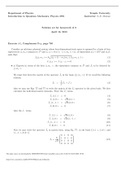Tentamen (uitwerkingen)
Homework 6 Solutions Temple University PHYSICS 3701
- Vak
- Instelling
Department of Physics Temple University Introduction to Quantum Mechanics, Physics 3701 Instructor: Z.-E. Meziani Solution set for homework # 6 April 16, 2013 Exercise #2, Complement FVI, page 765 Consider an arbitrary physical system whose four-dimensional state space is spanned by a basis of...
[Meer zien]




